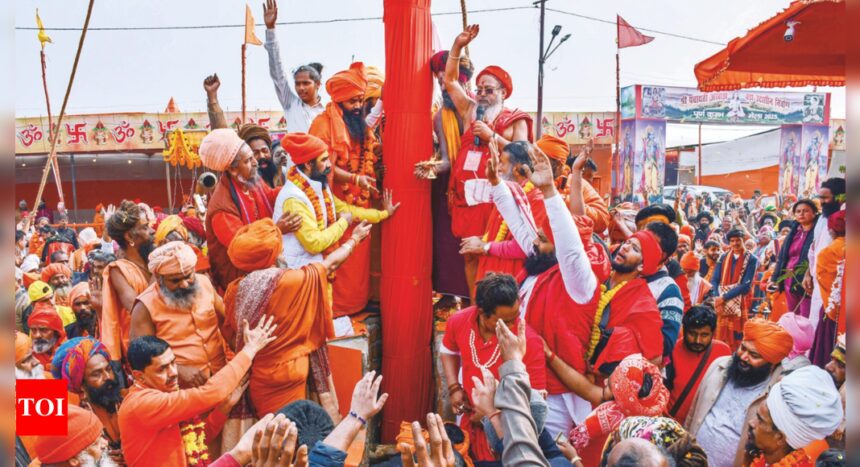Overview of Prominent Akharas in Hindu Philosophy
1. Shri Panch Dashnaam Juna Akhada
- Location: Baba Hanuman Ghat, Varanasi, Uttar Pradesh
- Established: 1146 AD (originally as Juna; prior known as Bairagis)
- Leadership: Acharya Mahamandaleshwar Swami Avdheshanand Giri
- Deity: Dattatreya
- Unique Features: This akhara is the largest and most diverse, welcoming all seekers and even those who keep dogs as companions. It aligns with the Dashnami sect and is renowned for its extensive tradition of weapons (astra) and scriptures (shaastra). It has the highest number of Naga Sanyasis, Hatha Yogis, and Sanyasins, and it has embraced the newly formed Kinnar Akhara.
2. Shri Panchayati Akhara Niranjani
- Location: Daraganj, Prayagraj, Uttar Pradesh
- Established: 904 AD
- Leadership: Acharya Mahamandaleshwar Kailashanandji Maharaj
- Deity: Kartikeya Swami
- Unique Features: Known as the second-largest akhara, it emphasizes education alongside spiritual growth and is distinguished by its learned seers. Established to protect Sanatan Dharma, its members consider one another as brothers and regard their founder as a guru.
3. Shri Panch Atal Akhara
- Location: Chaak Hanuman, Varanasi, Uttar Pradesh
- Established: 646 AD
- Leadership: Acharya Mahamandaleshwar Swami Vishwatmanand Saraswati
- Deity: Ganesha
- Unique Features: Among the oldest of the three akharas, it is recognized for exceptional discipline. This akhara promotes religious and ethical virtues and visualizes a sanyasi as one armed with a mala (rosary) in one hand and a bhaala (spear) in the other. It has historically opposed caste distinctions and Brahminical orders.
4. Shri Panchayati Akhara Mahanirvani
- Location: Daraganj, Prayagraj, Uttar Pradesh
- Established: 749 AD
- Leadership: Acharya Mahamandaleshwar Swami Vishokananda Maharaj
- Deity: Sage Kapilmuni (considered an incarnation of Lord Vishnu)
- Unique Features: This akhara pioneered the spiritual head concept of Mahamandaleshwar, promoting eco-friendly living. It aims to spread the tenets of Sanatan Dharma and has a rich tradition of religious investigation.
5. Shri Taponidhi Anand Akhara Panchayat
- Location: Trimbakeshwar, Nashik, Maharashtra
- Established: 1856 AD
- Leadership: Acharya Mahamandaleshwar Swami Balkanand Giri
- Deity: Surya
- Unique Features: Unlike others, this akhara facilitates freedom of expression and does not adhere to rigid protocols. It emphasizes appointing knowledgeable individuals devoted to Vedic education and the promotion of Indian culture.
6. Shri Panchdashnam Aawahan Akhara
- Location: Dashashwamedh Ghat, Varanasi, Uttar Pradesh
- Established: 547 AD
- Leadership: Acharya Mahamandaleshwar Arun Giri Maharaj
- Deity: Surya
- Unique Features: This akhara is recognized as a pioneer of Naga Sanyasis and was the first to set up a camp during the Kumbh. Its historical significance is marked by an event where Sanyasis, called upon by Adi Shankaracharya, won a battle after a transformative ritual.
7. Shri Panchdashnam Panch Agni Akhara
- Location: Girinagar, Bhavanath, Junagadh, Gujarat
- Established: 1192 AD
- Leadership: Acharya Mahamandaleshwar Shri Mat Ram Krishnanand
- Deity: Gayatri Mata
- Unique Features: This akhara does not include Naga Sanyasis and focuses on social initiatives such as free education and cow welfare. Its members, who are dedicated celibates, are committed to the study of scriptures and performing religious rituals.
8. Shri Digambar Ani Akhara
- Location: Shamlaji Kakchowk Temple, Sambhar Kantha, Gujarat
- Established: 1784 AD
- Leadership: Currently vacant
- Deity: Lord Hanuman
- Unique Features: This akhara comprises the highest number of Khalsas and is distinguished by its white-clad naga sadhus, who are willing to fight for their faith using both scriptural knowledge and weapons. They also engage in community welfare through langars during the Kumbh and Magh Melas.
9. Shri Panch Nirvani Ani Akhara Hanuman Garhi
- Location: Ayodhya, Uttar Pradesh
- Leadership: Shri Mahant Murli Das
- Deity: Lord Hanuman
- Unique Features: This akhara promotes wrestling and has contributed to constitutional development. Its seers are known for their distinctive tilak and a culture of promoting professional wrestling.
10. Akhil Bhartiya Shri Panch Nirmohi Ani Akhara
- Location: Dheer Sameer Mandir Bansivat, Vrindavan, Mathura, Uttar Pradesh
- Established: 1720 AD
- Leadership: Shri Mahant Rajendra Das Maharaj
- Deity: Lord Ram
- Unique Features: A significant participant in the Ram Temple movement, this akhara follows the Ramanandi sect, allowing participation from individuals of all castes, including women, who can also attain leadership roles.
11. Shri Panchayati Bada Udasin Akhara
- Established: 1825 AD
- Location: Krishnanagar, Prayagraj, Uttar Pradesh
- Leadership: Shri Mukhiya Mahant Durgadas (alongside three other Mukhiyas)
- Deity: Guru Chandradev
- Unique Features: This akhara rejects caste segregation and has actively participated in the freedom movement, adhering to the principles of devotion, knowledge, and renunciation.
12. Shri Panchayati Naya Udasin Akhara
- Location: Kankhal, Haridwar, Uttarakhand
- Established: 1846 AD
- Leadership: Mahant Jagtar Muni
- Deity: Guru Chandracharya
- Unique Features: This group is dedicated to community service and maintains various public welfare initiatives, providing food and shelter during major festivals.
13. Shri Nirmal Panchyati Akhara
- Location: Kankhal, Haridwar, Uttarakhand
- Established: 1856 AD
- Leadership: Shri Gyan Dev
- Unique Features: Known for its proximity to Sikh traditions, the Nirmal Akhara maintains close ties with Khalsa Sikhs and embraces a shared history with the guidance of Guru Gobind Singh.
This overview highlights the essence and contributions of various akharas in Hindu spirituality and culture, illustrating their unique roles and responsibilities within the broader religious community.








